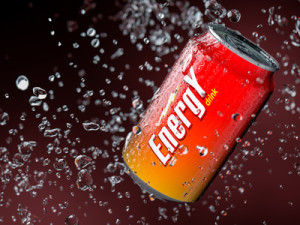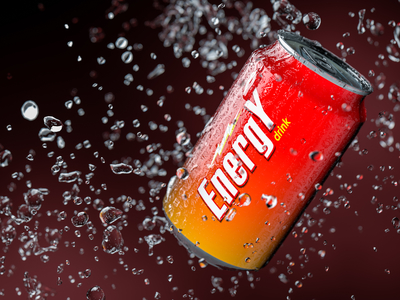
A healthy 26-year-old Hispanic man with no family history and no apparent risk factors for hear attack went to an ER in Texas complaining of left-sided chest pains. He arrived at the hospital about nine hours after he began having chest pain. “His left arm felt numb, he was sweating profusely and he reported vomiting prior to his arrival at the hospital.” He reported to the medical personnel that he drank between 8 and 10 energy drinks that day, his typical daily consumption of energy drinks.
In addition, the man also had a pack a day smoking habit for the past two years. He underwent a cardiac catheterization where a 100% occlusion of his left circumflex artery was found. There was no evidence on underlying artery plaque in that region of his heart. And no other evidence of coronary artery disease in his other coronary vessels was noted. A stent was placed in the occluded artery. After two days, he was discharged. “He agreed to stop smoking and consuming energy drinks.” Read a published case report of his medical treatment here.
The authors hypothesized that the large amount of energy drink consumption contributed to the acute thrombus blocking the man’s blood vessel. Excessive levels of caffeine and the possible effects of other substances contained in the energy drinks contributed to the man’s heart problem. They also acknowledged a reasonable alternative hypothesis was that his smoking caused or contributed to his “coronary artery vasospasm.”
Energy drinks have actually been around for a long time, with cocaine-laced Coca Cola being one of the first. Pemberton’s original formula included five ounces of coca leaf per gallon of syrup. Coca-Cola was estimated to contain about nine milligrams of cocaine per glass. It was removed from the syrup formula in 1903 and replaced with caffeine.
The modern introduction of energy drinks can be traced to the initial sale of “Red Bull” in 1997. Today there are a wide variety of additional energy drinks (such as Rock Star and Monster) with multiple energy-producing ingredients. The most common are: caffeine, taurine, glucuronolactone, and ginseng. Guarana is another caffeine-based stimulant commonly used in energy drinks. A typical energy drink contains between 75 milligrams to over 200 milligrams of caffeine per serving. This compares to 34 mg in Coke and 55 mg in Mountain Dew. Eight ounces of brewed coffee contains between 65 and 120 mg of caffeine. Two ounces of espresso contains 60 to 100 mg.
Brown University has a handy page of information on energy drinks where it noted that if a drink advertises no caffeine, the energy probably comes from guarana. Short-term dangers from energy drinks include: increased heart rate and blood pressure (sometimes to the point of heart palpitations), dehydration, and sleep disturbance. Occasional use of energy drinks was not seen as harmful, but the claims of some for improved performance and concentration was said to be misleading. Thinking of them as highly-caffeinated drinks gives you a more accurate picture of how they affect you.
Mixing energy drinks (a stimulant) with alcohol (a depressant) brings with it a number of potential dangers. The energy drink can give the person the impression they aren’t impaired from the alcohol; or prevent them from realizing how much alcohol they have consumed. “No matter how alert you feel, your blood alcohol concentration (BAC) is the same as it would be without the energy drink.” Once the energy drink wears off, fatigue, respiratory depression and vomiting can occur. Both substances are very dehydrating and can hinder the body’s ability to metabolize alcohol, increasing its toxicity—and therefore the hangover you get the next day.
The FDA has been collecting reports on adverse effects from energy drinks within its Center for Food Safety and Adverse Event Reporting System (CAERS). A report tracking adverse events from Red Bull between January of 2004 and October of 2012 had 22 adverse events. The noted symptoms ranged from dehydration, vomiting, convulsions, anxiety and aggression, to vertigo, blindness, pancreatitis, chest pain, increased heart rate and blood pressure.
Another FDA CAERS report noted adverse events for 5-Hour Energy (92), Monster (40), and Rockstar (13). The symptoms ranged from vomiting, dizziness, increased heart rate, anxiety and diarrhea to convulsions, chest pain, loss of consciousness and even death. There were eleven deaths related to the 5-Hour Energy reports, five for the Monster reports and none for Rockstar.
Health concerns with energy drinks are not just confined to FDA adverse events. A Live Science article last year by Tia Ghose reported that more than 5,000 cases of people getting sick from energy drinks were reported to US poison control centers between 2010 and 2013. Many of the cases involved serious side effects like seizures, irregular heart rhythms, and dangerously high blood pressure. Children under the age of six were frequently consuming the beverages without knowing what they were drinking. Stephen Lipshultz, a pediatrician from Michigan, noticed the association in 2007 and began tracking data from poison control centers from around the world.
In 2011, Lipshultz and his colleagues published their findings in the journal Pediatrics. They discovered that self-report surveys found that energy drinks are used by 30% to 50% of adolescents and young adults. In 2007, 46% of the 5,448 reported caffeine overdoses occurred in those younger than 19 years of age. Energy drinks were found to have no therapeutic benefit. Both the known and unknown pharmacology of the various ingredients in them, combined with reports of toxicity, suggested that energy drinks put some children at risk for serious adverse health effects.
Long-term research objectives should aim to better define maximum safe doses, the effects of chronic use, and effects in at-risk populations (eg, those with preexisting medical conditions, those who consume energy drinks during and after exercise, or those who consume them in combination with alcohol), and better documentation and tracking of adverse health effects. Unless research establishes energy-drink safety in children and adolescents, regulation, as with tobacco, alcohol, and prescription medications, is prudent.
A new study by researchers at the Yale School of Public Health found that middle school children who consume energy drinks are 66% more likely to be at risk for hyperactivity/inattention (ADHD) symptoms. They said that interventions to reduce sweetened beverage consumption should focus on energy drinks and other emerging sweetened beverages such as sports and sweetened coffee drinks. “Boys were more likely to consume energy drinks than girls.”
Over the last few years I’ve seen a regular parade of energy drinks consumed by individuals in early recovery. However I don’t think I ever knew someone drinking 8 to 10 of them daily. Doing the research for this article impressed upon me their potential to contribute to the instability of early recovery. So I think I’ll begin paying more attention to who is drinking them and how many energy drinks they consume.





